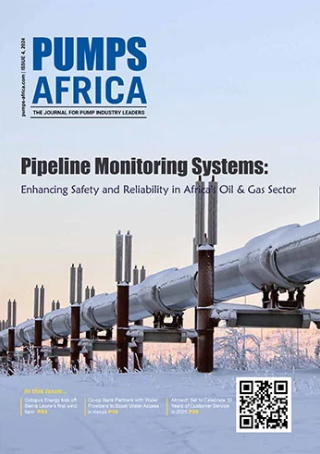African cities are currently grappling with significant urban infrastructure challenges resulting from rapid population growth and urbanization. Cities are expanding at an unprecedented rate on the continent, with millions of people migrating to cities in search of better opportunities. This increase in population density is putting enormous pressure on existing infrastructure systems, especially in the areas of water supply, sanitation, and hygiene. Many urban centers are ill-prepared to handle this influx, resulting in numerous service deficiencies that affect the quality of life of urban residents.
Water supply remains one of the most pressing issues in many African cities. Inadequate infrastructure sometimes results in systemic problems, including inadequate supply, poor water quality, and limited access to clean drinking water for a significant proportion of the population. In addition to water scarcity, many cities’ sewerage systems are aging and cannot effectively treat stormwater. These deficiencies often result in severe flooding during heavy rains, exacerbating the risks associated with urban living. Sanitation is also a significant challenge, as many urban areas lack the facilities and services necessary for proper waste disposal. Open defecation and improper waste disposal still exist and pose serious public health risks. The impact of these challenges on urban infrastructure is far-reaching and includes increased incidence of waterborne diseases, economic losses and negative environmental impacts.
Given these pressing issues, it is clear that efficient pumping solutions are essential to strengthen the resilience of urban infrastructure. Innovative pumping technologies play a key role in improving water supply systems, enhancing drainage capacity and providing effective sanitation solutions. Addressing these challenges through new approaches to pumping systems is fundamental for sustainable urban development across Africa.
New Pumping Technologies and Their Benefits
The development of pumping technologies is becoming increasingly important in improving urban infrastructure in Africa. Some of the most notable innovations include solar-powered pumps, smart pumps with Internet of Things (IoT) sensors, and energy-efficient designs. These advanced systems are not only transforming how water is managed, but also solving key challenges in urban environments.
Solar-powered pumps are gaining attention because they can harness renewable energy to power areas with limited access to the grid. By harnessing solar energy, these pumps contribute to sustainability efforts while significantly reducing operational costs. This is particularly advantageous for rural and urban outskirts where access to electricity is irregular or nonexistent. Case studies such as installations in Kenya and Tanzania show how solar-powered pumps have improved water supply and reliability in these communities.
Smart pumps represent a further advancement by integrating IoT sensors that enable real-time monitoring and control of pumping systems. These systems collect data on flow rates, pressure levels and system performance, enabling predictive maintenance and timely intervention. This capability improves the reliability of water distribution networks and reduces the possibility of breakdowns and costly downtime. Successfully deployed in cities such as Johannesburg and Nairobi, smart pump technology shows its potential to improve urban water management. Additionally, energy-efficient pump designs are critical to meet growing energy demands, especially in rapidly urbanizing regions. By using highly efficient pump technology, cities can significantly reduce energy consumption while maintaining optimal performance. This is particularly important in Africa, where rising energy costs can strain budgets and hinder infrastructure development.
In summary, the use of innovative pump technologies offers many benefits to African urban infrastructure. From solar power solutions to smart IoT integrated systems and efficient designs, these technologies improve reliability, reduce costs, and support sustainable urbanization efforts across the continent.
Case Study: Successful Implementation of Pump Innovations in African Cities
Various cities across Africa have begun initiatives to improve urban infrastructure through innovative pumping systems. These advancements have significantly improved water distribution, waste management, and sanitation, demonstrating the transformative impact of modern technology in the field of urban development. In this section, we consider several notable case studies to illustrate these improvements.
A prominent example is the City of Cape Town in South Africa. The city suffered from severe water shortages before implementing an advanced water recycling and pumping system. The technology involved the use of intelligent water management software combined with highly efficient pumps to maximize water recovery from wastewater. The result was a significant increase in drinking water supplies, reducing reliance on traditional sources and allowing the city to effectively supply water to its growing population. This innovative approach not only addressed the immediate water shortage but also set a precedent for other cities facing similar challenges.
In Lagos, Nigeria, the introduction of an integrated waste management and pumping system has played a key role in improving sanitation. The system uses strategically placed pumping stations throughout the city to efficiently transport waste to treatment facilities. By using solar-powered pumps, Lagos has minimized energy consumption while increasing the overall efficiency of waste collection and disposal. This effort has significantly improved public health, reduced the spread of sanitation-related diseases, and raised living standards for city residents.
Another important example can be seen in Nairobi, Kenya, where a community-led initiative focused on improving drainage systems through innovative pumping technology gained traction. Residents worked with local authorities to deploy submersible pumps to reduce flooding during the rainy season. The technology has proven effective in keeping waterways clear, reducing the risk of property damage, and improving the city’s overall resilience.
Collectively, these case studies highlight the potential of innovative pumping systems to address critical urban infrastructure challenges in African cities. By leveraging technology and fostering community engagement, cities can create sustainable solutions that improve the quality of life for their residents.
Future Trends and Sustainability of Pumping Systems
The development of pumping systems in urban infrastructure is essential to address the challenges facing African cities. In the pursuit of sustainable urban development, the future of pumping systems is increasingly trending towards the integration of renewable energy sources. Solar and wind energy have proven to be viable alternatives to traditional fossil fuels, promoting environmentally friendly practices while reducing operational costs. For example, solar-powered pumps can significantly reduce reliance on non-renewable energy, combating both energy scarcity and environmental degradation. In addition to renewable energy, automation and smart technologies will transform pumping systems, improving their efficiency and reliability. Advanced control systems based on artificial intelligence can optimize water distribution, minimize water waste, and respond quickly to system failures. The Internet of Things (IoT) enables real-time monitoring and data analytics, allowing municipalities to make informed decisions and optimize their operations. Leveraging these advancements will not only make urban infrastructure more efficient, but also pave the way for sustainable growth for African cities.
However, implementing these innovations is not without challenges. Economic constraints, limited access to technology, and gaps in technical know-how can hinder the adoption of renewable energy and advanced automation of pumping systems. To overcome these obstacles, stakeholders must prioritize joint efforts, invest in capacity building, and establish financing mechanisms tailored to the specific needs of African cities. Public-private partnerships can play a key role in mobilizing resources and sharing knowledge, ultimately promoting urban infrastructure resilience.
By proactively addressing potential obstacles and considering future trends in sustainability, African cities can improve their pumping systems. This transition will not only improve urban infrastructure, but also contribute to broader goals such as climate resilience and social justice. We look forward to these opportunities, but a commitment to sustainable practices remains essential to building a better urban future for Africa.







